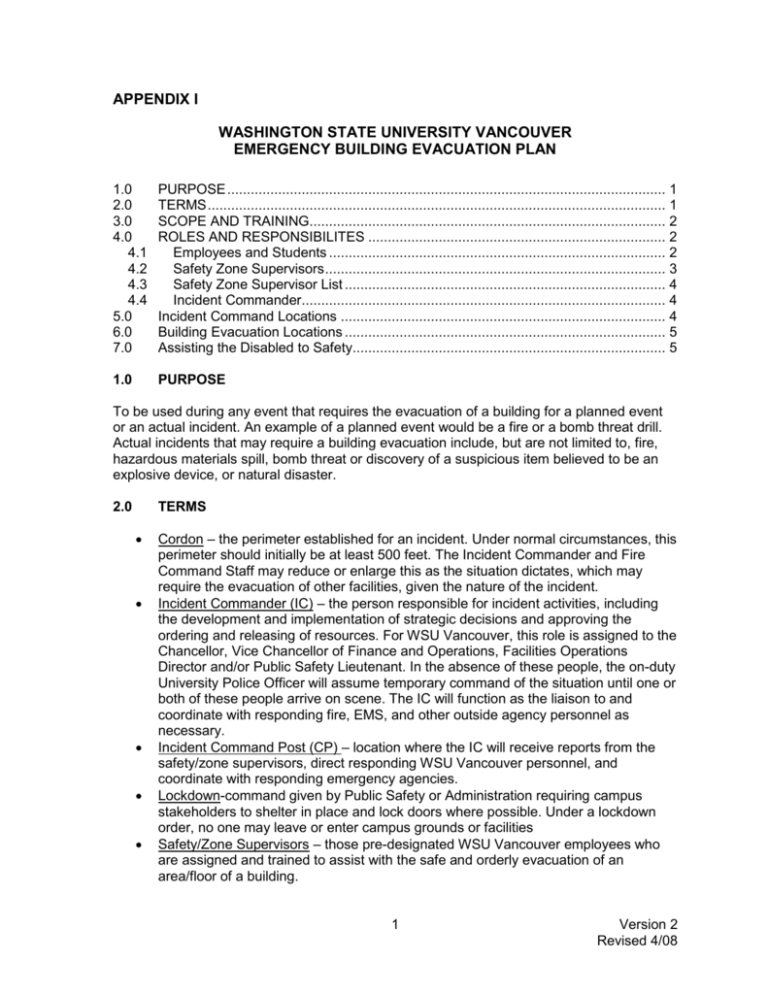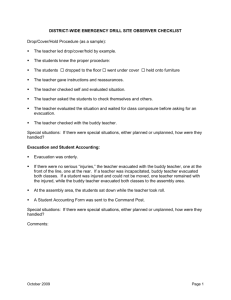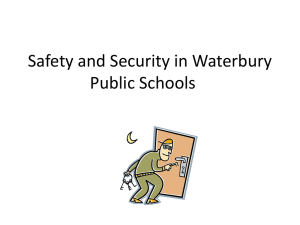emergency building evacuation plan
advertisement

APPENDIX I WASHINGTON STATE UNIVERSITY VANCOUVER EMERGENCY BUILDING EVACUATION PLAN 1.0 2.0 3.0 4.0 4.1 4.2 4.3 4.4 5.0 6.0 7.0 PURPOSE ................................................................................................................ 1 TERMS ..................................................................................................................... 1 SCOPE AND TRAINING........................................................................................... 2 ROLES AND RESPONSIBILITES ............................................................................ 2 Employees and Students ...................................................................................... 2 Safety Zone Supervisors ....................................................................................... 3 Safety Zone Supervisor List .................................................................................. 4 Incident Commander............................................................................................. 4 Incident Command Locations ................................................................................... 4 Building Evacuation Locations .................................................................................. 5 Assisting the Disabled to Safety................................................................................ 5 1.0 PURPOSE To be used during any event that requires the evacuation of a building for a planned event or an actual incident. An example of a planned event would be a fire or a bomb threat drill. Actual incidents that may require a building evacuation include, but are not limited to, fire, hazardous materials spill, bomb threat or discovery of a suspicious item believed to be an explosive device, or natural disaster. 2.0 TERMS Cordon – the perimeter established for an incident. Under normal circumstances, this perimeter should initially be at least 500 feet. The Incident Commander and Fire Command Staff may reduce or enlarge this as the situation dictates, which may require the evacuation of other facilities, given the nature of the incident. Incident Commander (IC) – the person responsible for incident activities, including the development and implementation of strategic decisions and approving the ordering and releasing of resources. For WSU Vancouver, this role is assigned to the Chancellor, Vice Chancellor of Finance and Operations, Facilities Operations Director and/or Public Safety Lieutenant. In the absence of these people, the on-duty University Police Officer will assume temporary command of the situation until one or both of these people arrive on scene. The IC will function as the liaison to and coordinate with responding fire, EMS, and other outside agency personnel as necessary. Incident Command Post (CP) – location where the IC will receive reports from the safety/zone supervisors, direct responding WSU Vancouver personnel, and coordinate with responding emergency agencies. Lockdown-command given by Public Safety or Administration requiring campus stakeholders to shelter in place and lock doors where possible. Under a lockdown order, no one may leave or enter campus grounds or facilities Safety/Zone Supervisors – those pre-designated WSU Vancouver employees who are assigned and trained to assist with the safe and orderly evacuation of an area/floor of a building. 1 Version 2 Revised 4/08 3.0 Staging Area-the location where additional responding personnel and equipment are assigned to until needed. Shelter in Place-finding shelter in a secure fire area (stairwell behind fire doors) during fire evacuations or securing classroom, office and building doors and staying in place during a lockdown event. Staging Area – the location where additional responding personnel and equipment are assigned to until needed. SCOPE AND TRAINING Each floor of each building will have a primary and alternate safety zone supervisor. It is the responsibility of these individuals to be knowledgeable of this emergency plan, a copy of which will be provided to each person upon assignment to this position. These individuals will attend an initial training session, as well as annual refresher training, sponsored by the Department of Public Safety and the WSU Vancouver Safety Committee. The Facilities Operations Director and Public Safety Lieutenant will have thorough knowledge of this plan. In addition, the on duty public safety officer will have knowledge of this plan and notify the Lieutenant immediately should the plan need to be implemented. These individuals have the primary responsibility for overseeing the implementation of this plan in the event of an actual emergency situation. In addition, these individuals will coordinate and oversee at least one evacuation drill annually per facility. When feasible, all training and drills should be planned with and coordinated to include the participation of Fire District 6 personnel. A copy of this plan will be provided to Fire District 6. 4.0 ROLES AND RESPONSIBILITES 4.1 Employees and Students Employees and students will: Evacuate when instructed to do so by university officials, Fire Department or Law Enforcement personnel, or upon the activation of the fire alarm system. Proceed in an orderly fashion out of the building and proceed to designated areas as directed. Keep clear of all emergency access routes and not interfere with or delay responding emergency personnel or vehicles. Remain clear of the incident area/building until directed by emergency personnel that the area is safe to reenter. Lock doors and shelter in place during a lockdown event. Some of the people listed for a building floor may not be in their area when an emergency develops. As such, it is the responsibility of all supervisors to be knowledgeable of these procedures and ensure that their floor is safely evacuated during an emergency. If a person is away from their area and an emergency develops they are to leave the building like anyone else. Do not attempt to reach your work area. It should be made clear that failure to leave the building during an evacuation is not only a violation of law; it is a violation of Washington State University rules. For employees, failure to evacuate may result in disciplinary action, in addition to penalties prescribed by law that 2 Version 2 Revised 4/08 can include the termination of employment of the individual. Students who fail to evacuate may also be subject to on campus judicial disciplinary actions in addition to legal sanctions. 4.2 Safety Zone Supervisors Safety Zone Supervisors will: Be familiar with the layout of their building’s floor. Know where exits are located as well as the primary and alternate evacuation routes for their floor/area. During a lockdown event, assist with securing doors, and providing direction to stakeholders while sheltering in place. During an evacuation, steer people to the nearest exit in an orderly fashion. Remember that panic is contagious; so remain calm. Ensure disabled individuals are evacuated using established procedures (see section 7.0: Assisting the Disabled to Safety). Ensure that first aid kits located in their area of responsibility taken to the evacuation staging area. Briefly check unlocked areas and rooms and shut doors and windows on their way out of the building. This will greatly slow down the spread of a fire. Exception: FOR BOMB THREATS – open doors and windows to lessen damage in the event of a blast. This is opposite from a fire evacuation but important to remember! ALSO FOR BOMB THREATS – assign certain employees to conduct a quick office search for foreign or unfamiliar objects or packages. The employees know better what belongs and what does not belong in their office areas and will recognize objects out of place. Anything found is not to be touched and must be reported immediately to the Incident Commander. Meet in a designated spot, at least 300 feet from the building, and conduct a head count. Be sure to keep people/vehicles well clear of responding emergency personnel. Report to the Incident Commander the following information: That their area is clear, a description of any damage or hazards observed, if anyone is missing/unaccounted for, and the location of injured or disabled that cannot be moved, if applicable. Assist with preventing people from reentering the building until competent authority (Fire or Public Safety personnel) gives the “all clear.” This includes assisting emergency personnel in maintaining a safe zone around the facility until relieved. Report any problems or observations noted to the Incident Commander after the event is over. Examples may include: Any person who refuses to leave or is stubborn in their attitude about leaving. Safety deficiencies noted during the evacuation that need to be addressed such as burnt out emergency lights, fire doors that do not activate, elevators not recalling to the first floor, malfunctioning alarms or PA announcements, etc. Safety/Zone Supervisors should NOT: 3 Version 2 Revised 4/08 Attempt to put out any fire unless they are trained to do so and the attempt is a reasonable thing to do. Physically remove anyone who refuses to leave the building. Instead, this must be reported to the Incident Commander along with the person’s location in the building. Reenter the building to look for anyone known to be unaccounted for. This must also be reported to the Incident Commander along with where this person might be located inside the building. Conduct lengthy searches of rooms checking for people. Allow anyone to use elevators unless directed by fire department personnel. Leave your designated area except to report to the Incident Commander. 4.3 Safety Zone Supervisor List Contact Public Safety for a list of the Building Safety Zone Supervisors. 4.4 Incident Commander The Incident Commander (IC) will: Establish the initial incident cordon, initial command post and staging area locations, and an area for the media to set up. As part of this, the IC will: Direct WSU Vancouver Facilities Operations Personnel, Public Safety Personnel, and Safety/Zone supervisors in establishing the initial cordon to keep people clear of the incident. This includes keeping avenues of approach, such as roads and access routes, clear for responding emergency vehicles and personnel. Initiate mutual aid from police, fire and rescue as required. Initiate the recall of off-duty Public Safety and/or Facilities Operations Personnel as necessary. Initiate all necessary notifications to the WSU Vancouver Administrative staff and, if necessary, or directed to do so, assist with the implementation of the WSU Vancouver Emergency Operations Plan and/or the WSUV Crisis Communications Plan. As a minimum, the following will need to be notified: WSU Vancouver Chancellor WSU Vancouver Vice Chancellor of Finance and Operations WSU Vancouver Facilities Operations Director. WSU Vancouver Communications Coordinator. Report to the responding fire department person in charge upon their arrival. The report will consist of the following information gathered from the safety/zone supervisors: Details regarding the type of emergency and assistance required. Whether or not the building is completely evacuated. Who, if anyone, is missing and if they are in the area of danger. A detailed description of the problem. Where in the building the problem is. The problem as it is reported by the safety/zone supervisors; the who, what, where, when, how, etc. Updates on any missing people, if located, how many, where, etc. Remain at the Incident Command Post during the entire incident to assist by providing additional information about the layout of the building, new construction, etc. Act as a liaison between fire department, EMS, other agencies responding, and WSU Vancouver personnel (administration, maintenance, and public affairs/media relations). 5.0 Incident Command Locations 4 Version 2 Revised 4/08 With the exception of lockdown events, Safety Zone supervisors will report to the Incident Commander (IC), who will be located at a predetermined Incident Command Post (CP) location. Safety Zone Supervisors are responsible to know these locations. Contact Public Safety for IC command locations. 6.0 Building Evacuation Locations Access the Public Safety website, or contact Public Safety or your Safety Zone Supervisor for evacuation locations. 7.0 Assisting the Disabled to Safety WSU Vancouver views the term disability broadly as it relates to emergencies. Evacuation procedures must not only address the needs of people with mobility, hearing, visual, speech or cognitive impairments but also those with medical conditions such as heart disease, arthritis, asthma, history of seizures, respiratory conditions, and emotional or psychiatric conditions. Faculty, safety/zone supervisors, and supervisory staff with disabled people under their direction, must ensure they discuss with that person how to safely evacuate them from a building. It is important to recognize that those with disabilities know their limitations and abilities better than anyone else. As such, they may already know what is needed to safely evacuate them from an area during an emergency. Evacuation of disabled people who are otherwise ambulatory, such as the blind or hearing impaired, should take place normally with other building occupants. These people can benefit from an escort, or buddy system, and should be provided one from within the class or work area. It should be noted that a blind person familiar with a building may have superior ability to escape through smoky conditions to a sighted person. Evacuation of people who are dependent upon equipment for their mobility should not use elevators unless directed to do so by the fire department or other emergency personnel. As stairs are often times difficult if not impossible to traverse, these individuals must either be transported out of the building by other means or be protected in place awaiting arrival of the fire department. Manual techniques for lifting and/or carrying individuals require training and proper application. All safety/zone supervisors will receive training in basic manual lifting techniques, such as the fireman’s carry and the two-person chair carry methods. Individuals that cannot be evacuated from the building, due to mobility problems, should proceed to the nearest safe stairwell in the building with a prearranged escort. Safety/Zone supervisors may need to assist with accomplishing this. Once the stairs have begun to clear of other evacuating people, enter the stairwell and have the person remain on the landing near the door with an escort. The exact location of the disabled person must be relayed without delay to Incident Commander and responding emergency personnel. Getting this information to emergency response personnel is critical to the safety of the individual and must not be delayed. 5 Version 2 Revised 4/08






